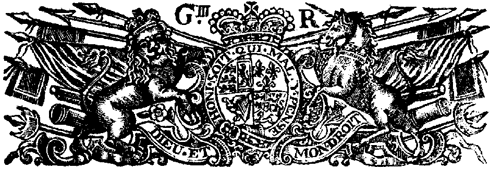

The First Foot Guards
We are a Revolutionary War
reenactment group based in Boston MA,
accurately portraying the royal household regiment that is now known as
The Grenadier Guards
Heraldry is a descriptive system of hereditary coats of arms, and everything that is associated with it (badges, flags and the like). It is described in a succinct language called 'blazon', which exactly delineates the colors and shapes.
The trophy of arms depicted above inclides the royal coat of arms of King George III.
Heraldry became systematized about 1200 AD, and flourished as a working art
up to about 1600. Since that time its use has been mainly ceremonial, although
it embodies a wealth of historical information and associations. From 1800 it
saw a needless increase in complexity, and today many people erroneously believe
they have a right to family arms associated with others of the same name.
So to understand the heraldry of King George III, we need to look at its antecedents.
1198-1340
Three yellow lions on red.
At the dawn of true hereditary heraldry, the arms of England made their appearance on Richard the Lionheart's (Richard I) second great seal, although he is believed to have used either a lion rampant or two lions affrontes before that (as shown on his first seal), and his father Henry II used a lion rampant. His younger brother (who became King John) had a seal in 1177 with two lions passant guardant.
Same arms continued for John, Henry III, Edward I, and Edward II.
Blazon
of the royal arms of England: Gules in pale three lions passant guardant
or.
Gules = red. In this case, the color of
the field (which is always cited first.)
In pale = organized on a central vertical axis.
Lions = not realistic lions, heraldic stylizations.
Passant = of a quadruped: facing left (as viewed) body horizontal, three legs
on the ground, the left front leg stretched forward, tail reflexed back over
the body.
Guardant = the face of the animal facing out to the observer. Passant would
have the beast facing forward, unless qualified by another description such
as 'guardant'.
Or = gold or yellow.
You see how succinct the blazon is!
1340-1603 England and France
In 1340 Edward III
asserted his claim to the kingdom of France through his mother Isabelle de France.
He expressed his claim heraldically by quartering the arms of England with those
of France, with France in quarters 1 and 4.
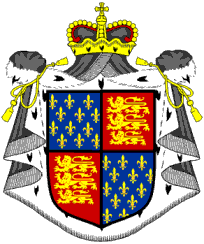
Blazon
of the royal arms of England: Quarterly of France and England.
France ancient: Azure semy of fleurs de lys or.
England: Gules in pale three lions passant guardant or.
Azure = blue field.
Semy = 'seeded' or scattered across the field in a wallpaper, so that the fleurs-de-lys
at the edges are cut off in places.
Fleur-de-lys = the familiar lily pattern, so symbolic of France
(but also used by the Italian city-state of Firenze, and others).
King Richard II, a pious man, marshalled his arms side by side with the (presumed) arms of King Edward the Confessor.
In response to new heraldic practices, the French royal arms were changed in 1405 or 1406 to three fleurs-de-lys on a blue ground, and also changed in the English royal arms to reflect the continued claim to the throne.
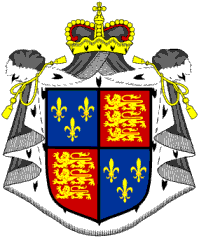
Blazon
of the arms: Quarterly of France and
England.
France modern: Azure three fleurs de lys or.
England: Gules in pale three lions passant guardant or.
Now the fleurs-de-lys are each larger, and each occupy about a third of the field.
Supporters of the
arms: Usually two lions rampant guardant, but some monarchs used other supporters.
Supporters
= In late to modern heraldry two beasts (or humans) placed either side of the
shield in a full achievement of arms.
Same arms continued
for Henry V, Henry VI, Edward IV, Edward V, Richard III, Henry VII,
Henry VIII, Edward VI, Mary I, and Elizabeth.
Circa 1550, during Mary's reign, the arms of England were sometimes impaled
(placed side to side with) with
the arms of King Philip II of Spain, her husband.)
The English flag was the cross of St George: a white field with a red cross throughout.
In 1603 James VI of Scotland ascended the throne of England as James I of England, and the following year changed his style (his title) to that of King of Great Britain. The name of the country changed to Great Britain, and the flag changed to the Union Flag (as borne by the First Foot Guards).
These arms remained the same for Charles I, Charles II, and James II.
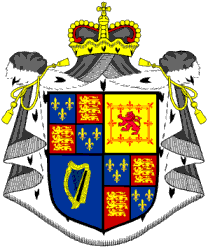
Blazon
of the Royal Arms of Great Britain: Grandquarterly, 1 and 4 quarterly France
and England,
2 Scotland, 3 Ireland.
Quarters I and 4 contained the quarterly France & England design.
Scotland: Or within a double tressure flory counter-flory gules, a lion rampant
gules.
Ireland; Azure a harp
Tressure
= a border
Flory counter-flory = the tressure has fleurs-de-lys arranged alternately pointing
in and out.
Rampant = of a beast, standing on one foot facing left, the other three limbs
clawing the air in an artistic attitude, the tail reflexed to the back, the
face pointing left.
Supporters of the
arms: A lion (on the left) for England, and a unicorn (on the right) for Scotland.
When the arms were borne in Scotland the lion and unicorn positions were reversed.
These are the supporters as seen on the
gable of the Old State House in Boston.
Henry VIII had proclaimed himself king of Ireland in 1541 but the kingdom's arms had not previously been incorporated into the royal arms (perhaps because he understood he could never truly rule the Irish!)
The new British flag was formed by combining the flags of England and Scotland.
England: The cross of St George. On a white field a red cross. A 'cross' has its arms organized horizontally and vertically. Its edges run off the sides of the field. (It would be termed couped if its limbs did not reach the edges of the field; or if it were a long way short it would be 'couped close' as in the arms and flag of Switzerland.)
Scotland: The saltire of St Andrew. On a blue field a white diagonal cross.
The flag is formed by taking the Scottish flag and superimposing the red cross (along with a white edging to reflect its original white field). This is the arrangement as on the regimental colors of the First Foot Guards.
This flag became more complex with The act of Union of 1801, becoming the present day 'Union Jack'.
The impaled coats of William and Mary, proclaimed king and queen in England in February 1689 and in Scotland in April 1689. They are identical, except that William bears an escutcheon of Nassau overall.
Impaled = the organization of two coats of arms on one shield by putting them side by side. Pale = a vertical bar.
William III and Mary II- From 1689-1702, an escutcheon of Nassau was added.
Nassau = Azure billetty and a lion rampant or.
While William reigned alone after Mary's death he used his arms, without those of Mary,as above.
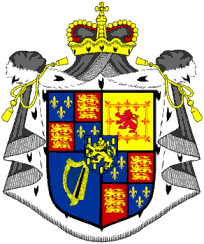
Queen Anne, Mary's sister, returned to her father's arms as they had been used from 1603 to 1688.
Anne -- In 1707, the arms of England and Scotland were moved to the first and fourth quarters, the arms of France in the second, and the arms of Ireland in the third.
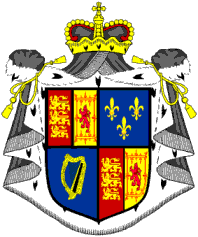
The Act of Union united the kingdoms of England and Scotland and this union was signified by a rearrangement of the arms.
Blazon: Quarterly 1 and 4, England and Scotland impaled, in quarter 2 France, in quarter 3 Ireland.
The accession of the House of Hanover brought yet another modification.
George I - In 1714, the fourth quarter was changed to three sections tierced per pale and per chevron for Hanover: (1) Gules two lions passant guardant or; (2) Or semy of hearts gules a lion rampant azure; and (3) Gules a horse courant argent. Overall, an escutcheon of pretence gulescharged with the Crown of Charlemagne.) Same arms for George II
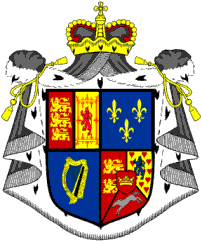
The fourth quarter, was replaced with the arms of Hanover:
Hanover: tierced per pale and per chevron, 1: gules two lions passant guardant or (Braunschweig), 2: or a semy of hearts gules a lion rampant azure (Lüneburg), 3: gules a horse courant argent (Westfalen), over all an escutcheon gules charged with the crown of Charlemagne or (dignity of arch-Treasurer of the Holy Roman Empire).
Tierced = divided
into three parts (such a description needs to be qualified by a further description).
Tierced per pale and per chevron = divided into three parts like a three-pointed
star (upper point vertical).
Brunswick: gules two lions passant guardant or. (Similar to the old English arms, but with two lions, not three).
Lüneburg: or a semy of hearts gules a lion rampant azure
Semy of hearts = a wallpaper pattern of hearts (in this case red on a gold field)
Westphalia: gules a horse courant argent. (On a red field a white horse running to the left) The white horse is often seen on British army hats of this period.
Over all = placed
on top of what already has been described on a shield. It might therefore cover
certain elements already on the arms.
Escutcheon = small shield shape
Charged = on
the shield. That is, on the red escutcheon there is a naturalistic representation
of Charlemagne's crown.
The duke of Braunschweig-Lüneburg had titled himself "Elector of the Holy Roman Empire" from 1698, and had added to his arms an escutcheon gules with an electoral bonnet. From 1711 he also bore the title of Arch-Treasurer, and the escutcheon then took a crown of Charlemagne.
The Act of Union
between Great Britain and Ireland took effect on January 1, 1801.
A proclamation of 1 January 1801 set the royal style and titles and modified the arms, dropping the quarter of France. The claim to France was ipso facto dropped, but it had become moot with the demise of the French royal family.
The arms of England now occupied the first and fourth quarters, the arms of Scotland the second, and the arms of Ireland the third. For Hanover, there was an escutcheon overall surmounted by the electoral bonnet, which was replaced in 1816 by a Royal Crown (when Hanover became a Kingdom).

The flag was changed to incorporate the saltire of St Patrick (a blue diagonal cross on a white field). The saltire was placed on top of the existing white saltire of St Andrew (a white saltire on a blue field), but not on top of the St George's cross and its white background. Yes it is complicated, but just look at a modern 'Union Jack' and you'll see the organization. Because the St Patrick's saltire is not placed centrally on the St Andrew's saltire, it is actually possible to fly the flag upside down. I would notice, retired army colonels would notice, and hopefully now you would notice and have such a dastardly situation corrected forthwith!
In 1814, the king
of the United Kingdom became king of Hanover (until 1806 and the dissolution
of the Holy Roman Empire, he had been Elector of Brunswick-Lunenburg or Hanover).
A proclamation of Jun 8, 1816 (published in the London Gazette of 29
June 1816) ordered that the royal Hanoverian crown be placed over the escutcheon
of pretence, instead of the electoral bonnet.
With the accession of Victoria in 1837, the kingdom of Hanover went to another line by application of the Salic law ( a woman could not succeed to the throne of Hanover), and the Hanover escutcheon disappeared
About
the Hanoverian kings
Brief thumbnail descriptions